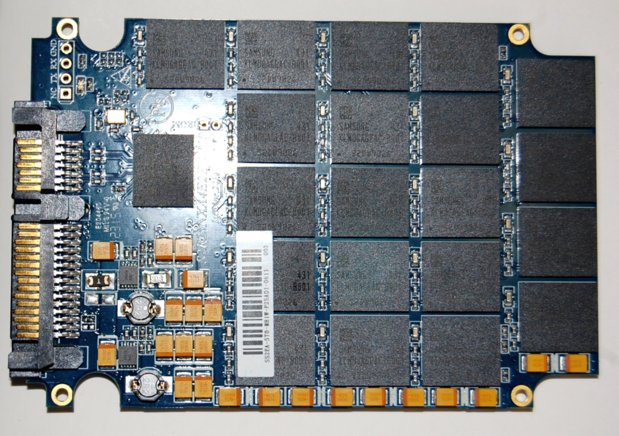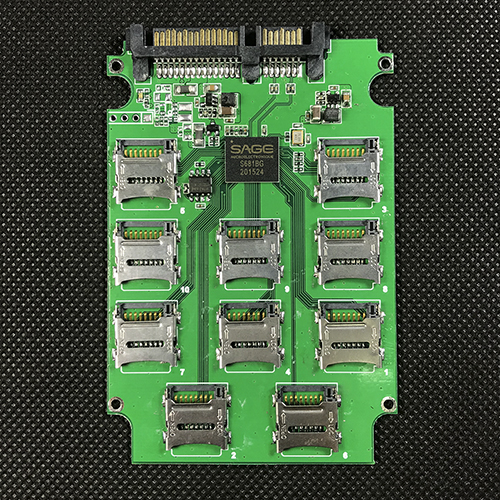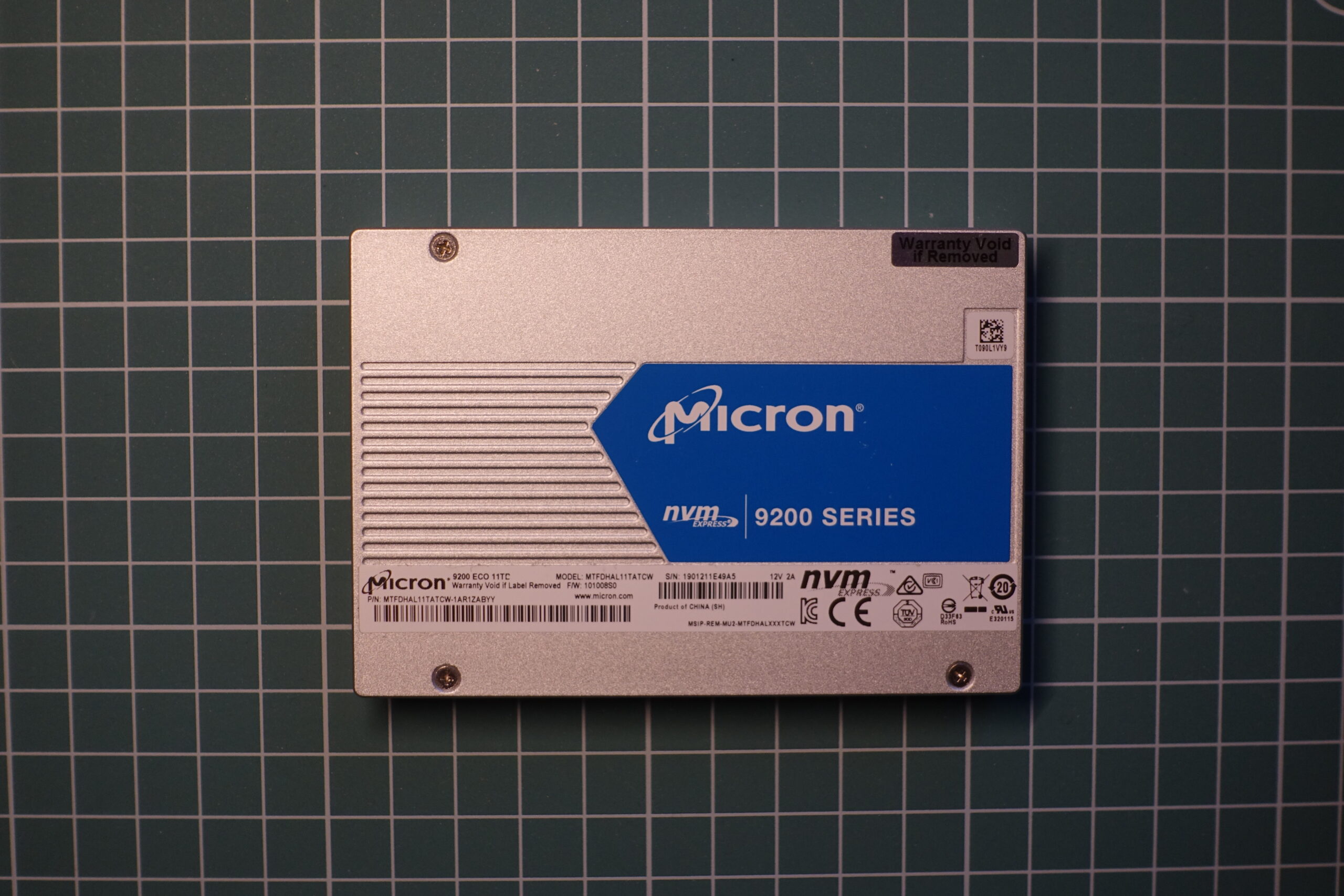Enterprise form factors
In this section I would like to go through the specifics of enterprise drives and their use in mainstream desktop PCs.
M.2
There are quite a few enterprise drives using the familiar M.2 form factor, mainly in its 110mm long variant. These often have power loss protection and may not be as power efficient as a desktop drive. 80mm enterprise M.2 drives may be problematic in laptops, even if they do fit, as they are often missing the power saving features that a consumer drive would have and thus would likely drain the laptop’s battery more quickly.
U.2 vs U.3
So what’s the difference? They appear the same, but are not quite the same thing. You can pop a U.3 drive on a U.2 connector, but you can’t use a U.2 drive in a U.3 slot. Why? Well, that’s a long story.
The U.2 connector was created with NVMe SSDs in mind. You could fit SATA and SAS drives in the same slot, but they are electronically incompatible. They probably wouldn’t get fried, but they certainly won’t function properly. That’s because a U.2 host connector only has four PCIe lanes routed to it and therefore it can’t work with SATA or SAS drives.
This is where U.3 comes in. The U.3 host connector is universal. That means it can support both NVMe, SAS and SATA drives67. This requires support on both the controller and backplane side, and it also means that it uses a slightly different pinout and is capable of detecting the type of the drive that is plugged in.
Most U.3 drives are designed in a way that they will work with both U.2 and U.3 hosts, but due to the different pinout, a U.3 host is not able to communicate with U.2 drives. In practice, a U.2 cable will more than likely work with most U.3 drives as well, just make sure that the drive isn’t shoved away and is receiving enough airflow to keep cool.
SAS drives
Newer SAS drives come with 12Gb/s interfaces and many has dual-port support. That means the drive has two SAS interfaces which can be used in conjunction for redundancy or higher speeds. This latter part is what most are interested in and it requires some special cabling. It is not easy to obtain and there is an entire thread on the topic on STH, so check that out if it’s of any interest to you.
Using the two ports for redundancy often requires backplanes and two host nodes with software support, so it would be quite difficult to achieve with mainstream hardware.
Some novelties
There are a few more drives that I think are worth bringing up, primarily for their uniqueness, as they weren’t always particularly useful or widely adopted.
Sage Microelectronic has supposedly created the first 10TB SSD in Q4 201568. Or rather, they announced one, but I’m unable to find any reviews on any of their drives, suggesting that they were probably never released. However, they did provide some technical details on how they accomplished these high capacities and it appears they used eMMC modules, connected to a (semi-?)custom controller. Their 5TB69 drive utilized 40 pieces of 128GB eMMC modules in a striped configuration, connected to this controller, which in turn provided a SATA interface to connect it to a PC.

This was supposedly an SSD, but in reality, it was a just bunch of eMMC drives glued together without any form of PLP and it also lacked any sort of redundancy, aside from what little the eMMC modules may have had built-in. At least they were supposedly using MLC flash internally, but even then, under no circumstances would I classify this as an enterprise-grade drive.
MemoryPack sells a MicroSD to SATA SSD RAID adapter, named the MPK10TF25SSD, which seems to be using a Sage-branded controller, potentially the same as the one used by drive above, which is another interesting, although not particularly useful way of using it. However, as eMMC uses the same interface as SD cards, they are interchangeable. There is another, generic variant of this adapter witht he same controller, which has microSD sockets on one side, and solder pads for eMMC packages on the other.

- SSDs in 2008: fast speeds (200MB/sec) over price cuts | Ars Technica ↩︎
- 64GB SSD on the Desktop: Samsung and OCZ go mainstream (anandtech.com) ↩︎
- Intel X25-M SSD: Intel Delivers One of the World’s Fastest Drives (anandtech.com) ↩︎
- Intel’s X25-M 80GB SSD ships this week for $595 | Engadget ↩︎
- Intel announces its first SSDs, plans to ship in a month | Engadget ↩︎
- K9NCG08U5M-PCB0T00 by Samsung Electronics | Flash | Arrow.com ↩︎
- Samsung swaggers in with 100GB SSD • The Register ↩︎
- Intel’s X25-E SSD Walks All Over The Competition | Tom’s Hardware (tomshardware.com) ↩︎
- OCZ Summit 120GB SSD review > Summit 120GB In Detail | TechSpot ↩︎
- Crucial RealSSD C300 Review (256GB) – StorageReview.com ↩︎
- Crucial RealSSD C300 64GB SSD Review | bit-tech.net ↩︎
- Crucial C300 64Gb RealSSD Review | The SSD Review ↩︎
- The SSD Diaries: Crucial’s RealSSD C300 (anandtech.com) ↩︎
- Corsair Force Series GT Review (120GB) – StorageReview.com ↩︎
- SandForce SF-2000 Series SSD Overview | SandForce,SSD,SF-2141,SF-2181,SF-2281,SF-2282,SF-2382,SF-2582,SF-2682,Solid State Drive,SandForce SF-2000 Series SSD Processor Technical Overview and Specifications by Olin Coles (techplayboy.com) ↩︎
- Random & Sequential Read/Write Speed – Corsair Neutron & Neutron GTX: All Capacities Tested (anandtech.com) ↩︎
- The Seagate 600 & 600 Pro SSD Review (anandtech.com) ↩︎
- Samsung SSD 850 Pro (128GB, 256GB & 1TB) Review: Enter the 3D Era (anandtech.com) ↩︎
- Sun F40/F80 to Seagate WarpDrive firmware (RAID Mode) | ServeTheHome Forums ↩︎
- OCZ RevoDrive 3 X2 480GB Review – StorageReview.com ↩︎
- OCZ RevoDrive Hybrid Review – StorageReview.com ↩︎
- Intel SSD 910 Series Enterprise PCIe Review – StorageReview.com ↩︎
- Fusion-io ioDrive Duo Enterprise PCIe Review – StorageReview.com ↩︎
- Micron RealSSD P320h Enterprise PCIe Review – StorageReview.com ↩︎
- Micron P320h PCIe SSD (700GB) Review (anandtech.com) ↩︎
- Huawei Tecal ES3000 Application Accelerator Review – StorageReview.com ↩︎
- Samsung SSD XP941 Review: The PCIe Era Is Here (anandtech.com) ↩︎
- Intel SSD DC P3700 Review: The PCIe SSD Transition Begins with NVMe (anandtech.com) ↩︎
- Intel SSD DC P3700 Review: The PCIe SSD Transition Begins with NVMe (anandtech.com) ↩︎
- Power Consumption – Intel SSD DC P3700 Review: The PCIe SSD Transition Begins with NVMe (anandtech.com) ↩︎
- First Look: Inside a 2.5″ SFF Intel DC P3700 400GB Drive (servethehome.com) ↩︎
- Samsung XS1715 1.6TB 2.5-inch NVMe PCIe Enterprise SSD Review (tweaktown.com) ↩︎
- Samsung XS1715 2.5″ NVMe SSD Review – StorageReview.com ↩︎
- Samsung PM1725 SSD Review – StorageReview.com ↩︎
- Drives In Detail: Samsung & SK hynix – Enterprise NVMe Round-Up 2: SK Hynix, Samsung, DapuStor and DERA (anandtech.com) ↩︎
- NVMe Namespaces – NVM Express ↩︎
- PM8607 NVMe2016 | Microsemi ↩︎
- Intel SSD 750 PCIe SSD Review: NVMe for the Client (anandtech.com) ↩︎
- The Samsung 950 Pro PCIe SSD Review (256GB and 512GB) (anandtech.com) ↩︎
- Samsung SM951 (512GB) PCIe SSD Review (anandtech.com) ↩︎
- The Samsung 960 Pro (2TB) SSD Review (anandtech.com) ↩︎
- pun intended, obviously not everyone is going to be familiar with how the naming schemes are derived from the physical drive sizes ↩︎
- Toshiba Announces New BGA SSDs Using 3D TLC NAND (anandtech.com) ↩︎
- A First Look At Samsung’s PM971 Entry-Level NVMe SSD | Tom’s Hardware (tomshardware.com) ↩︎
- Samsung Demos Its First BGA SSD: 1500 MB/s Read Speed and Tiny Package (anandtech.com) ↩︎
- Storage Products SSD/HDD (semicon-storage.com) ↩︎
- Toshiba Announces New BGA SSDs Using 3D TLC NAND (anandtech.com) ↩︎
- The Best NVMe SSD for Laptops and Notebooks: SK hynix Gold P31 1TB SSD Reviewed (anandtech.com) ↩︎
- Ultra-Fast SSDs Coming: 2400 MT/s NAND in Mass Production | Tom’s Hardware (tomshardware.com) ↩︎
- Comparison: Latest 3D NAND Products from YMTC, Samsung, SK hynix and Micron | TechInsights ↩︎
- World’s First PCIe 4.0 SSD Demo, Phison E16 Hits 4GB/s | Tom’s Hardware (tomshardware.com) ↩︎
- Gigabyte Aorus NVMe Gen 4 review: The first PCIe 4.0 SSD has arrived | Rock Paper Shotgun ↩︎
- GIGABYTE AORUS Gen4 SSD 1TB, M.2 2280 / M-Key / PCIe 4.0 x4 (GP-AG41TB) | Price Comparison Skinflint UK ↩︎
- Some PCIe 5.0 SSDs Confined to 10 GBps; Others Hit 12.4 GBps | Tom’s Hardware (tomshardware.com) ↩︎
- Sabrent Developing Ultra Fast PCIe 5 SSD That Could Hit 14 GBps | Tom’s Hardware (tomshardware.com) ↩︎
- Nextorage NE5N SSD Review: One Thick SSD | Tom’s Hardware (tomshardware.com) ↩︎
- Silicon Motion Readies PCIe Gen5 SSD Platform with 3.5W Power Consumption [UPDATED] (anandtech.com) ↩︎
- China-based Maxio creates full line of PCIe 5.0 SSD controllers — capable of up to 14.8 GB/s | Tom’s Hardware (tomshardware.com) ↩︎
- China-made RISC-V PCIe 5.0 SSD controller promises competitive performance — up to 14.2 GB/s without a fan | Tom’s Hardware (tomshardware.com) ↩︎
- How 3D XPoint Phase-Change Memory Works – PC Perspective ↩︎
- The Intel Optane Memory H10 Review: QLC and Optane In One SSD (anandtech.com) ↩︎
- Intel Optane SSD 905P 960GB NVMe HHHL SSD Review – Bigger XPoint – PC Perspective ↩︎
- Intel Optane SSD 905P 1TB Performance Testing (tomshardware.com) ↩︎
- Intel Optane DC Persistent Memory Guide for PMem 100 PMem 200 and PMem 300 Optane DIMMs (servethehome.com) ↩︎
- Samsung 983 ZET Review – StorageReview.com ↩︎
- Samsung Z-SSD SZ985 | Samsung Semiconductor Global ↩︎
- What you need to know about U.3 | Automated Testing Tools (quarch.com) ↩︎
- Sage Microelectronics announces world’s first 10TB 2.5-inch SSD (betanews.com) ↩︎
- Sage Micro Displays High Density SSD – Flash Memory Summit 2015 Update | The SSD Review ↩︎

Leave a Reply